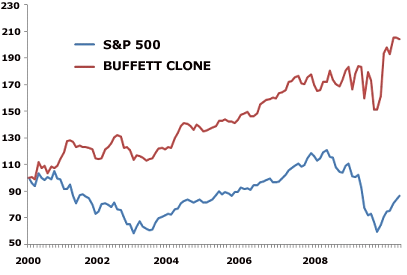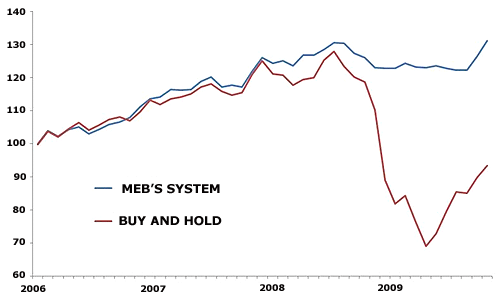By Dr. Steve Sjuggerud, Daily Wealth | 9 October 2009
"Using a form filed with the government that's available to everyone, we've found ways to beat the market by as much as 10% a year." Investment analyst Mebane Faber told me that recently (in so many words), over dinner with my good friend and mentor Van Simmons. Mebane ("Meb" for short) is a relatively unknown young analyst, but he's doing fantastic work…
Last week [[see below: normxxx]], I told you about his simple investing system that didn't lose money for 35 years. (It's from his book, The Ivy Portfolio: How to Invest Like the Top Endowments and Avoid Bear Markets.) What's more, it beat the market with less risk. And astoundingly, you only have to look at your portfolio once a month— 12 days a year. It's simple, but incredible… the mark of a great idea.
Last night, he explained another simple but incredible idea…
"Big investors— those with over $100 million— have to disclose their investment holdings in government filings called 13Fs," Meb explained. "The information is backward looking… But I've studied it, and it turns out it can be extremely valuable". One thing Meb does is "clone" the big hedge-fund managers, like George Soros, David Einhorn, and Seth Klarman. Through these government filings, he can use these gurus' expertise without paying them big fees.
Meb explained that "mining" these government forms to copy the best portfolios works best with investment managers who hold stocks for a long period of time… investors like the world's second-richest man, Warren Buffett. Let's take a closer look at how you could use Meb's ideas to "clone" Warren Buffett's portfolio out of the government filings…
The 13F filings are quarterly. To keep it simple, Meb takes Buffett's top-10 holdings and equally weights them in his portfolio. Three months later, when the new 13F filings come out, he changes the portfolio.
Meb said, "It turns out that a simple portfolio that invests in Buffett's top 10 stock holdings, equal-weighted and rebalanced quarterly, beat the market by 10% a year from 2000 through 2008". (A recent academic paper, called Imitation is the Sincerest Form of Flattery, corroborates Meb's research. It used a similar strategy from 1976 to 2008, and it beat the market by 11% per year.)

"Mining" these 13F forms turned out to be so valuable, Meb created a way to backtest these ideas automatically. He and his partner Maz Jadallah founded AlphaClone and made his program available to the public… for way too cheap (with a free 14-day trial and a "Guest Pass"). Now, you can easily backtest the performance of a portfolio that simply follows the stock ideas of the biggest and best money managers as soon as their portfolios are available through government filings.
If you're interested in picking your own stocks, or you'd like to see how you could have performed if you'd followed the best hedge-fund managers in the business, give AlphaClone a try. And keep an eye out for Mebane Faber. This young analyst keeps delivering original, simple ideas.
Good investing,
Steve
P.S. Follow Meb at this site and try his AlphaClone program.
.
This System Works So Well, I'm Not Sure I Should Tell You About It
By Dr. Steve Sjuggerud | 2 October 2009
If I weren't working on the same research myself, I wouldn't have believed it's possible… The results of this system are so powerful, I hesitate to share them with a large audience. But I get paid to share the best investment ideas I find. So I feel compelled to tell you about this one…
In short, investment analyst Mebane Faber came up with an incredibly "dumb" system that beats the market. It crushes it actually… Meb's system delivers the investment "Holy Grail"— higher returns with lower risk. It's hard to believe, but the system really is incredibly simple. And it's totally legit. While the traditional disclaimer "past performance doesn't equal future performance" applies, the fact is:
From 1973 (the start date for his data) through 2007, Meb's simple system never had a losing year. (Think about that!) In 2008, when everyone lost money, Meb's simple system beat everything and was barely down. (I'm not sure what the exact figure was, but I assure you, it was only slightly negative.)
I remembered Meb's story when I opened up the most recent issue of Fortune… It turns out, Harvard and Yale's college endowments are down 27% and 25%, respectively, in the 12 months ending June 30. I tell you this because I first learned of Meb's system in a book he wrote, called The Ivy Portfolio: How to Invest Like the Top Endowments and Avoid Bear Markets.
The book is interesting… He shows you how Harvard and Yale have beaten typical money managers over the long run, among other investment ideas. It's worth owning just for that section.
But what interested me most wasn't Harvard's famous system in the front half… it was Meb's unknown system later in the book. Way in the back, after all the stuff about the endowments, I found Meb's little timing system.
He wrote the book before the Great Recession. How has his system performed since? It's hitting new highs:

But that's the way it's always been… I think the worst performing 12-month period (out of all possible intra-year 12-month periods) was a loss of less than 10%. Great stuff.
In the simple version of Meb's system, you only look at the markets 12 days of the year. And there are only five funds to own: U.S. stocks, foreign stocks, bonds, commodities, and real estate stocks. In Meb's system, you have 20% of your portfolio in each of these five asset classes… and you are either in or out of each of them every month. So you might be only 40% invested one month, then 80% invested another month, depending on the system.
Look, Mebane Faber came up with this system… and he deserves credit for it… So I'm going to ask you to get it from him. Go to this site and get his book. Read his blog. If you want to know the "science" behind it, click on the "Timing Updates" tab and download his academic paper.
It's worth learning…
It's had only one down year since starting in 1973. [[2008, as noted.: normxxx]] And it's delivered the investment "Holy Grail" of higher returns with lower volatility… all in a portfolio of just five things that you only have to look at a dozen times a year.
What more could you want? Check it out.
Good investing,
No comments:
Post a Comment